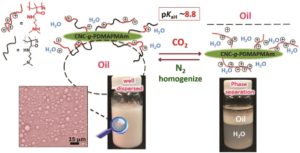Renewable bio-based colloidal particles in emulsion-based products can be highly desirable as they can replace synthetic, small molecule surfactants. Pickering stabilisers or emulsifiers are solid particles that can be used as insoluble surfactants to stabilise emulsions. For such application, cellulose appears to be a good renewable biopolymer candidate owing to its abundance, sustainability and nontoxicity. Cellulose nanocrystals (CNCs) in particular exhibit little to no cytotoxicity and can thus represent a more sustainable and greener alternative to conventional surfactants. Cunningham and co-workers introduced new properties to cellulose nanocrystals by exploiting their graft modification with switchable poly((diethylamino)ethyl methacrylate) (PDEAMEA) and poly((dimethylamino)ethyl methacrylamide) (DMAPMAm). In this work, the use of well-defined graft modified CNCs with small amounts of grafted CO2-switchable PDMAPMAm and PDEAEMA as stimuli-responsive Pickering stabilisers for the reversible emulsification/demulsification of oil and water is thoroughly investigated. The obtained CNCs contained less than 25 wt% of grafted synthetic polymer and impressively resulted in stable Pickering emulsions with a shelf life up to one month without desulfating the CNCs or the introduction of ionic strength to the system. N2 and CO2 were used as environmentally benign triggers to stabilise the emulsions under N2 and break the emulsions under CO2. Importantly, the emulsification and demulsification were reversible and repeatable and the CNC-based Pickering emulsifier could be easily recovered, thus enabling it to be a potential candidate for oil harvesting applications. Such Pickering emulsifiers are not expected to have significant ecotoxicity compared to other conventional surfactants due to the CNCs and the polymer chains being too large in molecular weight to be bioavailable. The authors conclude that a higher fraction of hydrophobic copolymer in the grafts may further improve their system and enhance the adsorption of graft-modified CNC to the oil droplets and increase the emulsion stability.
Tips/comments directly from the authors:
- It can be difficult to ‘switch off’ PDMAPMAm at room temperature using N2, meaning deprotonating the tertiary amine groups in water. To ensure sufficient wettability of CNC-g-P(DMAPMAm-co-S) with the oil phase when homogenizing, i.e. a high enough degree of deprotonation, the temperature of the CNC dispersion has to be slightly increased first (~40°C, although this depends by the chain length) before adding the oil phase and preparing the emulsion.
- For the synthesis of the materials (Polym. Chem., 2017, 8, 6000–6012), it is important that premade polymers are living and purified from unreacted monomer, BlocBuilder and dead polymer chains. Any nitrogen-containing impurity will artificially increase the nitrogen content obtained from elemental analysis and thus falsify the final value for the amount of grafted polymer, graft density and amino groups per 1 g of CNC. It is thus advisable to repeat the purification/elemental analysis until a constant N value is obtained.
- SEM analysis of the grafted CNC (ESI) can be very difficult unless the appropriate conditions are chosen. CNC needs to be coated with conductive material as the polymer and CNC are both non-conductive. The materials were coated with 3nm osmium particles using a standard 30 micron aperture probe at 300V. The current corresponded to 275 pA at 10kV. Low current and low voltage conditions need to be chosen in order to visualize the structures.
This paper is FREE to read and download until the 31st August!
Graft-modified cellulose nanocrystals as CO2-switchable Pickering emulsifiers, Polym. Chem., 2018, 9, 3864-3872
About the web writer
 Dr. Athina Anastasaki is a Web Writer for Polymer Chemistry. She is currently a Global Marie Curie Fellow working alongside Professor Craig Hawker at the University of California, Santa Barbara (UCSB). Please visit this link for more information.
Dr. Athina Anastasaki is a Web Writer for Polymer Chemistry. She is currently a Global Marie Curie Fellow working alongside Professor Craig Hawker at the University of California, Santa Barbara (UCSB). Please visit this link for more information.











